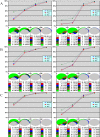Rodent-specific alternative exons are more frequent in rapidly evolving genes and in paralogs
- PMID: 19558667
- PMCID: PMC2711938
- DOI: 10.1186/1471-2148-9-142
Rodent-specific alternative exons are more frequent in rapidly evolving genes and in paralogs
Abstract
Background: Alternative splicing is an important mechanism for generating functional and evolutionary diversity of proteins in eukaryotes. Here, we studied the frequency and functionality of recently gained, rodent-specific alternative exons.
Results: We projected the data about alternative splicing of mouse genes to the rat, human, and dog genomes, and identified exons conserved in the rat genome, but missing in more distant genomes. We estimated the frequency of rodent-specific exons while controlling for possible residual conservation of spurious exons. The frequency of rodent-specific exons is higher among predominantly skipped exons and exons disrupting the reading frame. Separation of all genes by the rate of sequence evolution and by gene families has demonstrated that rodent-specific cassette exons are more frequent in rapidly evolving genes and in rodent-specific paralogs.
Conclusion: Thus we demonstrated that recently gained exons tend to occur in fast-evolving genes, and their inclusion rate tends to be lower than that of older exons. This agrees with the theory that gain of alternative exons is one of the major mechanisms of gene evolution.
Figures

Similar articles
-
Changes in alternative splicing of human and mouse genes are accompanied by faster evolution of constitutive exons.Mol Biol Evol. 2005 Nov;22(11):2198-208. doi: 10.1093/molbev/msi218. Epub 2005 Jul 27. Mol Biol Evol. 2005. PMID: 16049198
-
Conserved and species-specific alternative splicing in mammalian genomes.BMC Evol Biol. 2007 Dec 22;7:249. doi: 10.1186/1471-2148-7-249. BMC Evol Biol. 2007. PMID: 18154685 Free PMC article.
-
Alternative splicing in the human, mouse and rat genomes is associated with an increased frequency of exon creation and/or loss.Nat Genet. 2003 Jun;34(2):177-80. doi: 10.1038/ng1159. Nat Genet. 2003. PMID: 12730695
-
How prevalent is functional alternative splicing in the human genome?Trends Genet. 2004 Feb;20(2):68-71. doi: 10.1016/j.tig.2003.12.004. Trends Genet. 2004. PMID: 14746986 Review.
-
Sequence and Evolutionary Features for the Alternatively Spliced Exons of Eukaryotic Genes.Int J Mol Sci. 2019 Aug 6;20(15):3834. doi: 10.3390/ijms20153834. Int J Mol Sci. 2019. PMID: 31390737 Free PMC article. Review.
Cited by
-
Structure and expression of two nuclear receptor genes in marsupials: insights into the evolution of the antisense overlap between the α-thyroid hormone receptor and Rev-erbα.BMC Mol Biol. 2010 Dec 10;11:97. doi: 10.1186/1471-2199-11-97. BMC Mol Biol. 2010. PMID: 21143985 Free PMC article.
-
Correlated Evolution of Nucleotide Positions within Splice Sites in Mammals.PLoS One. 2015 Dec 7;10(12):e0144388. doi: 10.1371/journal.pone.0144388. eCollection 2015. PLoS One. 2015. PMID: 26642327 Free PMC article.
-
Assessment of orthologous splicing isoforms in human and mouse orthologous genes.BMC Genomics. 2010 Oct 1;11:534. doi: 10.1186/1471-2164-11-534. BMC Genomics. 2010. PMID: 20920313 Free PMC article.
-
Evolution of the Antisense Overlap between Genes for Thyroid Hormone Receptor and Rev-erbα and Characterization of an Exonic G-Rich Element That Regulates Splicing of TRα2 mRNA.PLoS One. 2015 Sep 14;10(9):e0137893. doi: 10.1371/journal.pone.0137893. eCollection 2015. PLoS One. 2015. PMID: 26368571 Free PMC article.
-
Diversity of protein and mRNA forms of mammalian methionine sulfoxide reductase B1 due to intronization and protein processing.PLoS One. 2010 Jul 9;5(7):e11497. doi: 10.1371/journal.pone.0011497. PLoS One. 2010. PMID: 20634897 Free PMC article.
References
Publication types
MeSH terms
Grants and funding
LinkOut - more resources
Full Text Sources

